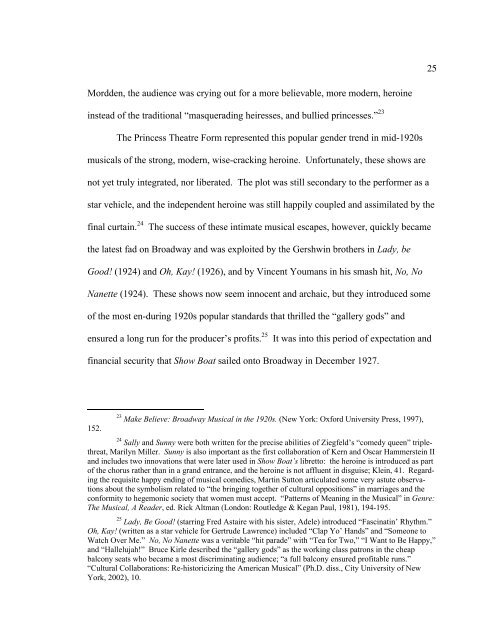Song Character Analysis Worksheet - The University of North ...
Song Character Analysis Worksheet - The University of North ...
Song Character Analysis Worksheet - The University of North ...
Create successful ePaper yourself
Turn your PDF publications into a flip-book with our unique Google optimized e-Paper software.
Mordden, the audience was crying out for a more believable, more modern, heroine<br />
instead <strong>of</strong> the traditional “masquerading heiresses, and bullied princesses.” 23<br />
<strong>The</strong> Princess <strong>The</strong>atre Form represented this popular gender trend in mid-1920s<br />
musicals <strong>of</strong> the strong, modern, wise-cracking heroine. Unfortunately, these shows are<br />
not yet truly integrated, nor liberated. <strong>The</strong> plot was still secondary to the performer as a<br />
star vehicle, and the independent heroine was still happily coupled and assimilated by the<br />
final curtain. 24 <strong>The</strong> success <strong>of</strong> these intimate musical escapes, however, quickly became<br />
the latest fad on Broadway and was exploited by the Gershwin brothers in Lady, be<br />
Good! (1924) and Oh, Kay! (1926), and by Vincent Youmans in his smash hit, No, No<br />
Nanette (1924). <strong>The</strong>se shows now seem innocent and archaic, but they introduced some<br />
<strong>of</strong> the most en-during 1920s popular standards that thrilled the “gallery gods” and<br />
ensured a long run for the producer’s pr<strong>of</strong>its. 25 It was into this period <strong>of</strong> expectation and<br />
financial security that Show Boat sailed onto Broadway in December 1927.<br />
152.<br />
23 Make Believe: Broadway Musical in the 1920s. (New York: Oxford <strong>University</strong> Press, 1997),<br />
24 Sally and Sunny were both written for the precise abilities <strong>of</strong> Ziegfeld’s “comedy queen” triplethreat,<br />
Marilyn Miller. Sunny is also important as the first collaboration <strong>of</strong> Kern and Oscar Hammerstein II<br />
and includes two innovations that were later used in Show Boat’s libretto: the heroine is introduced as part<br />
<strong>of</strong> the chorus rather than in a grand entrance, and the heroine is not affluent in disguise; Klein, 41. Regarding<br />
the requisite happy ending <strong>of</strong> musical comedies, Martin Sutton articulated some very astute observations<br />
about the symbolism related to “the bringing together <strong>of</strong> cultural oppositions” in marriages and the<br />
conformity to hegemonic society that women must accept. “Patterns <strong>of</strong> Meaning in the Musical” in Genre:<br />
<strong>The</strong> Musical, A Reader, ed. Rick Altman (London: Routledge & Kegan Paul, 1981), 194-195.<br />
25 Lady, Be Good! (starring Fred Astaire with his sister, Adele) introduced “Fascinatin’ Rhythm.”<br />
Oh, Kay! (written as a star vehicle for Gertrude Lawrence) included “Clap Yo’ Hands” and “Someone to<br />
Watch Over Me.” No, No Nanette was a veritable “hit parade” with “Tea for Two,” “I Want to Be Happy,”<br />
and “Hallelujah!” Bruce Kirle described the “gallery gods” as the working class patrons in the cheap<br />
balcony seats who became a most discriminating audience; “a full balcony ensured pr<strong>of</strong>itable runs.”<br />
“Cultural Collaborations: Re-historicizing the American Musical” (Ph.D. diss., City <strong>University</strong> <strong>of</strong> New<br />
York, 2002), 10.<br />
25

















